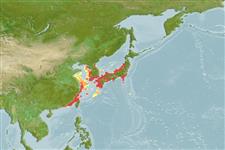Teleostei (teleosts) >
Tetraodontiformes (Puffers and filefishes) >
Tetraodontidae (Puffers) > Tetraodontinae
Etymology: Takifugu: A Japanese word with several meanings; taki = waterfall + fugu = fish; it could be also understood as taki = to be cooked in liquid + fugu = a venomous fish.
More on authors: Temminck & Schlegel.
Environment: milieu / climate zone / depth range / distribution range
Ecology
Marine; demersal. Temperate; 40°N - 22°N, 115°E - 145°E
Northwest Pacific: Japan to the East China Sea.
Size / Weight / Age
Maturity: Lm ? range ? - ? cm
Max length : 30.0 cm SL male/unsexed; (Ref. 559)
Dorsal spines (total): 0; Dorsal soft rays (total): 12 - 15; Anal spines: 0; Anal soft rays: 10 - 13. Body without prickles. Brown vermiculations dorsally, white ventrally. Pectoral and dorsal fins yellow; anal fin white; caudal fin yellow with dark rays (Ref. 559).
Occurs near shore (incl. semi-enclosed sea areas), and in estuaries (Ref. 11230). Used in Chinese medicine (Ref. 12166).
Life cycle and mating behavior
Maturity | Reproduction | Spawning | Eggs | Fecundity | Larvae
Masuda, H., K. Amaoka, C. Araga, T. Uyeno and T. Yoshino, 1984. The fishes of the Japanese Archipelago. Vol. 1. Tokai University Press, Tokyo, Japan. 437 p. (text). (Ref. 559)
IUCN Red List Status (Ref. 130435: Version 2024-1)
Threat to humans
Poisonous to eat (Ref. 559)
Human uses
Fisheries: commercial
Tools
Special reports
Download XML
Internet sources
Estimates based on models
Preferred temperature (Ref.
123201): 16.9 - 23.2, mean 20.4 °C (based on 80 cells).
Phylogenetic diversity index (Ref.
82804): PD
50 = 0.5000 [Uniqueness, from 0.5 = low to 2.0 = high].
Bayesian length-weight: a=0.02239 (0.00933 - 0.05373), b=2.90 (2.72 - 3.08), in cm total length, based on LWR estimates for this Genus-body shape (Ref.
93245).
Trophic level (Ref.
69278): 3.4 ±0.3 se; based on size and trophs of closest relatives
Resilience (Ref.
120179): Medium, minimum population doubling time 1.4 - 4.4 years (Assuming tm=2-4).
Fishing Vulnerability (Ref.
59153): Low to moderate vulnerability (27 of 100).
Climate Vulnerability (Ref.
125649): Very high vulnerability (80 of 100).
Nutrients (Ref.
124155): Calcium = 45.6 [20.2, 109.1] mg/100g; Iron = 0.433 [0.186, 1.013] mg/100g; Protein = 17.7 [15.6, 20.0] %; Omega3 = 0.512 [0.231, 1.099] g/100g; Selenium = 13.4 [6.6, 29.8] μg/100g; VitaminA = 9.41 [2.37, 37.88] μg/100g; Zinc = 0.527 [0.367, 0.827] mg/100g (wet weight);
